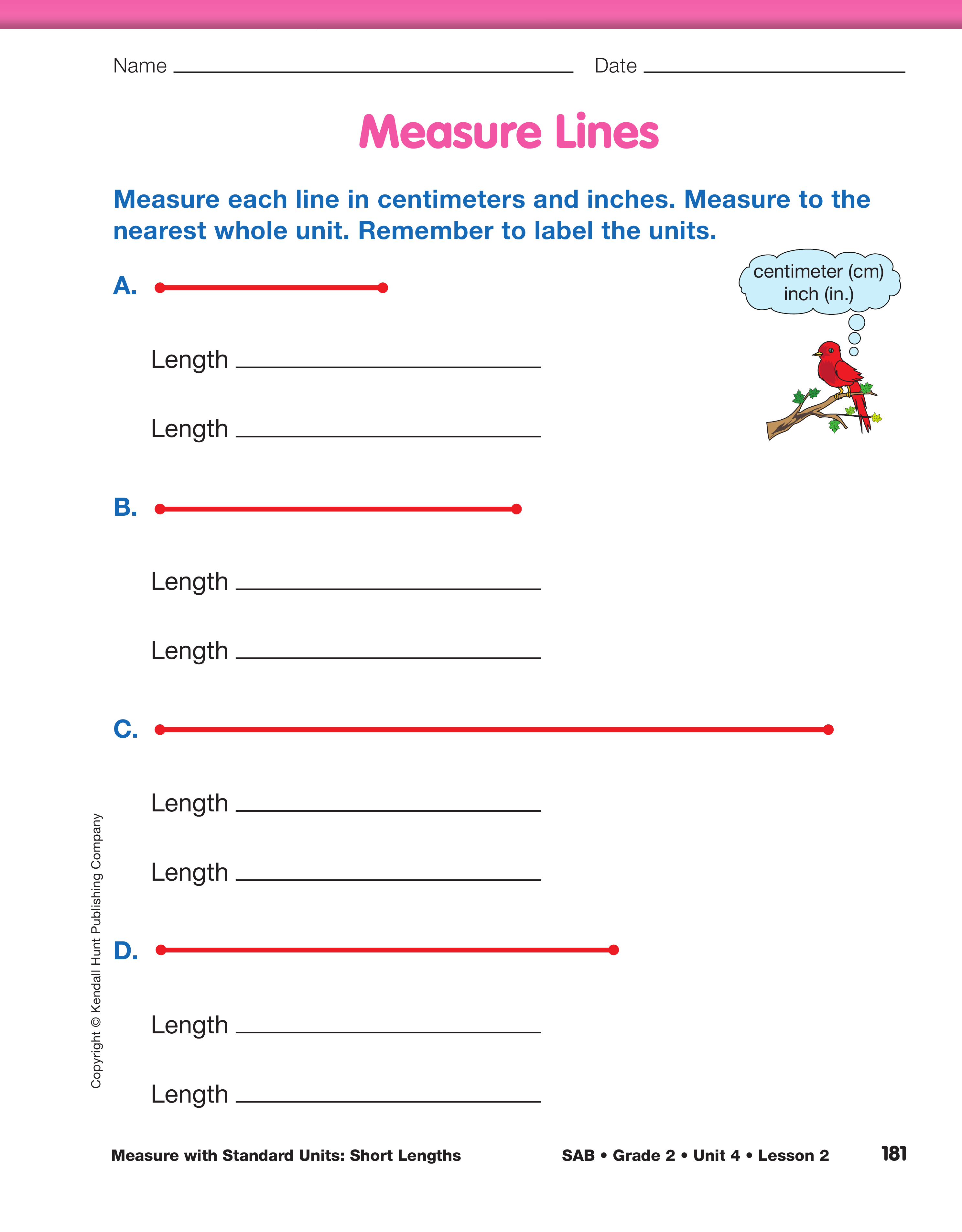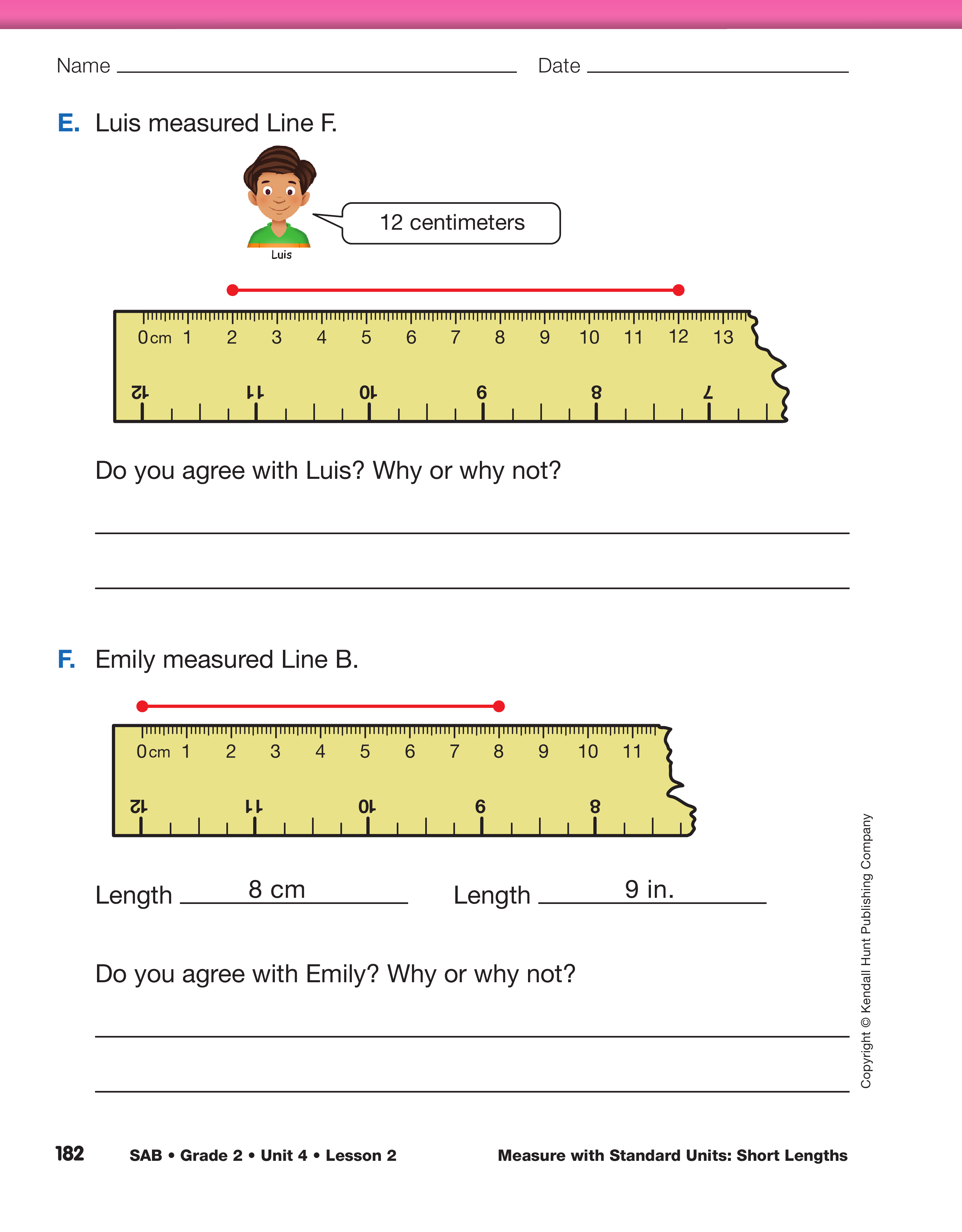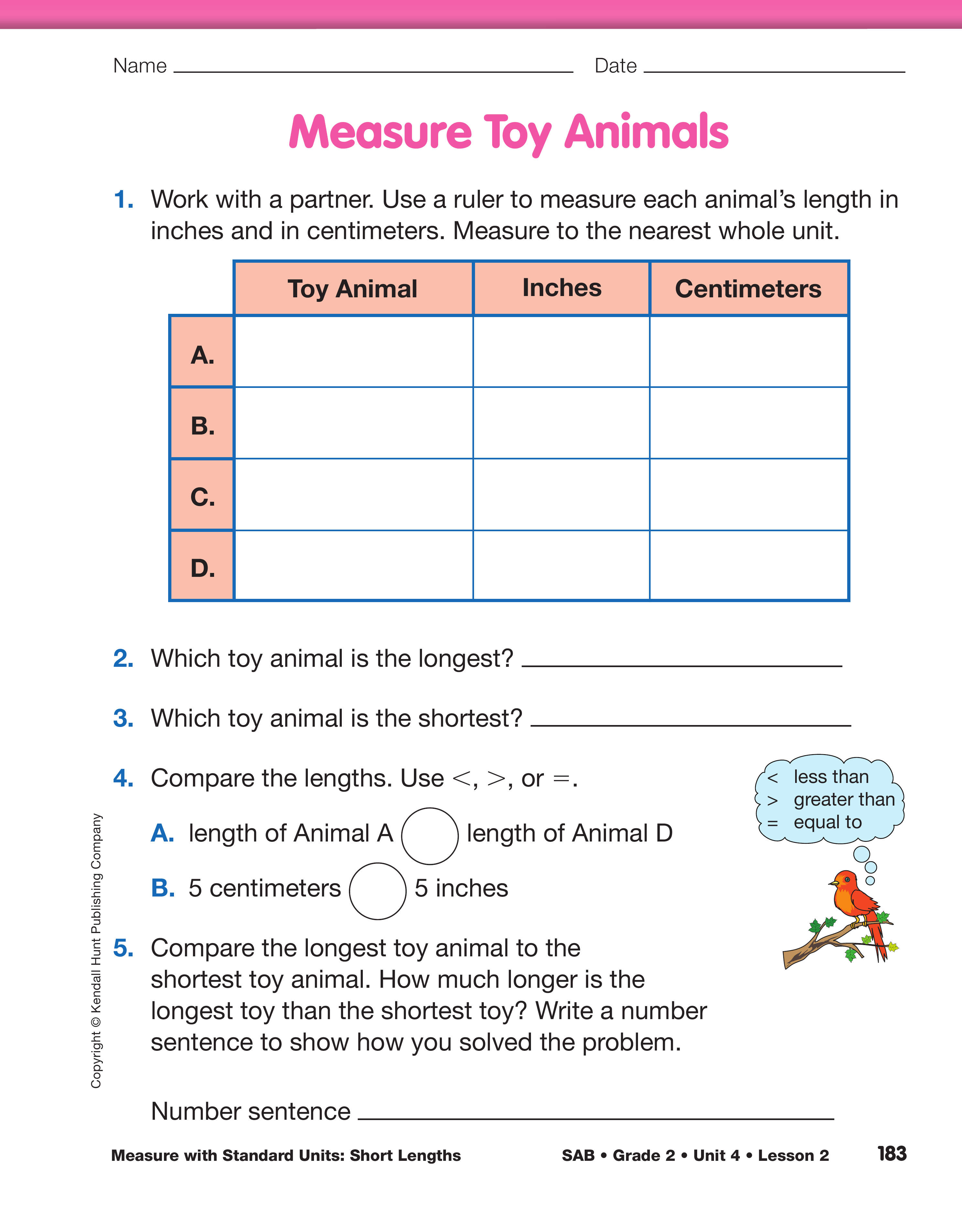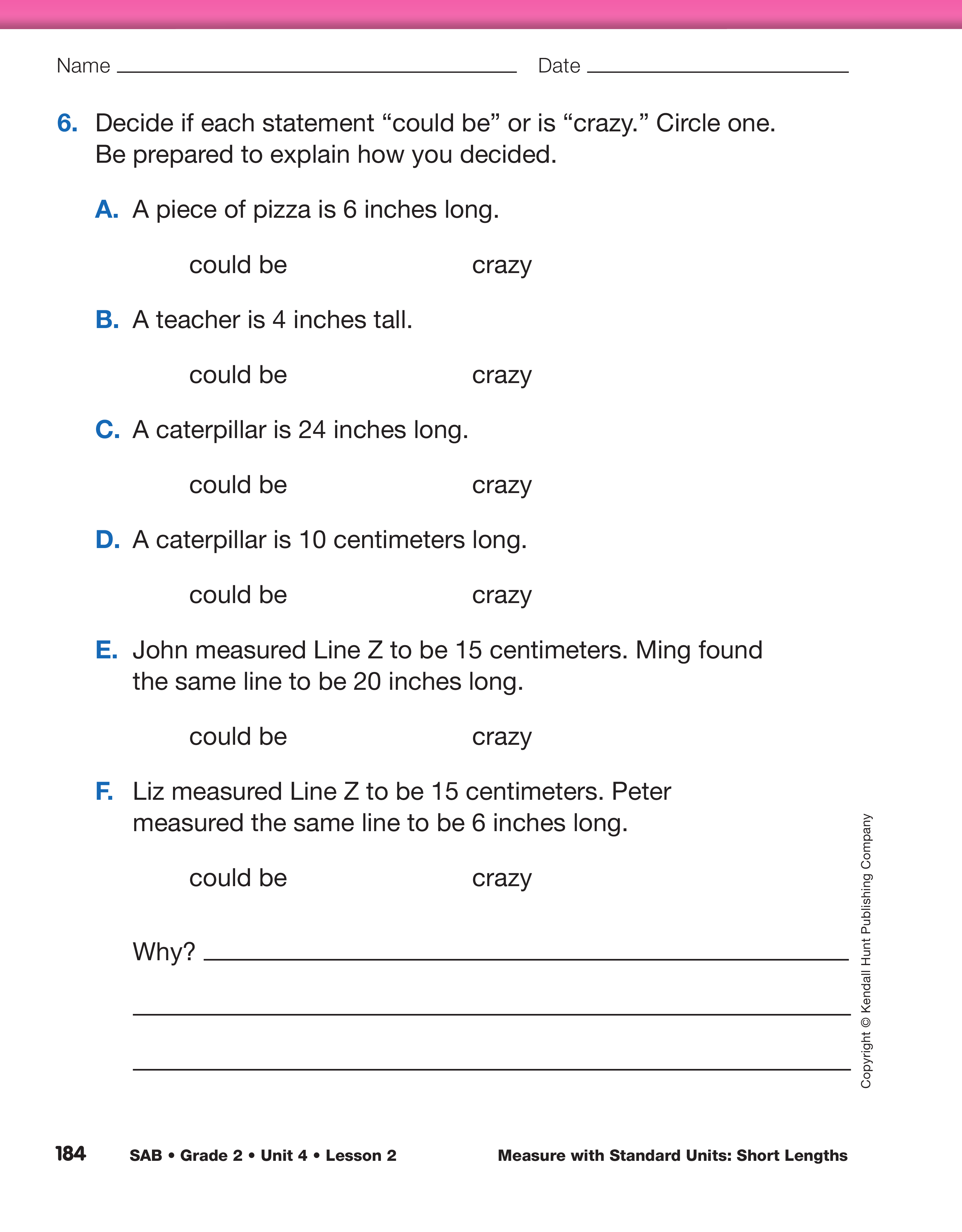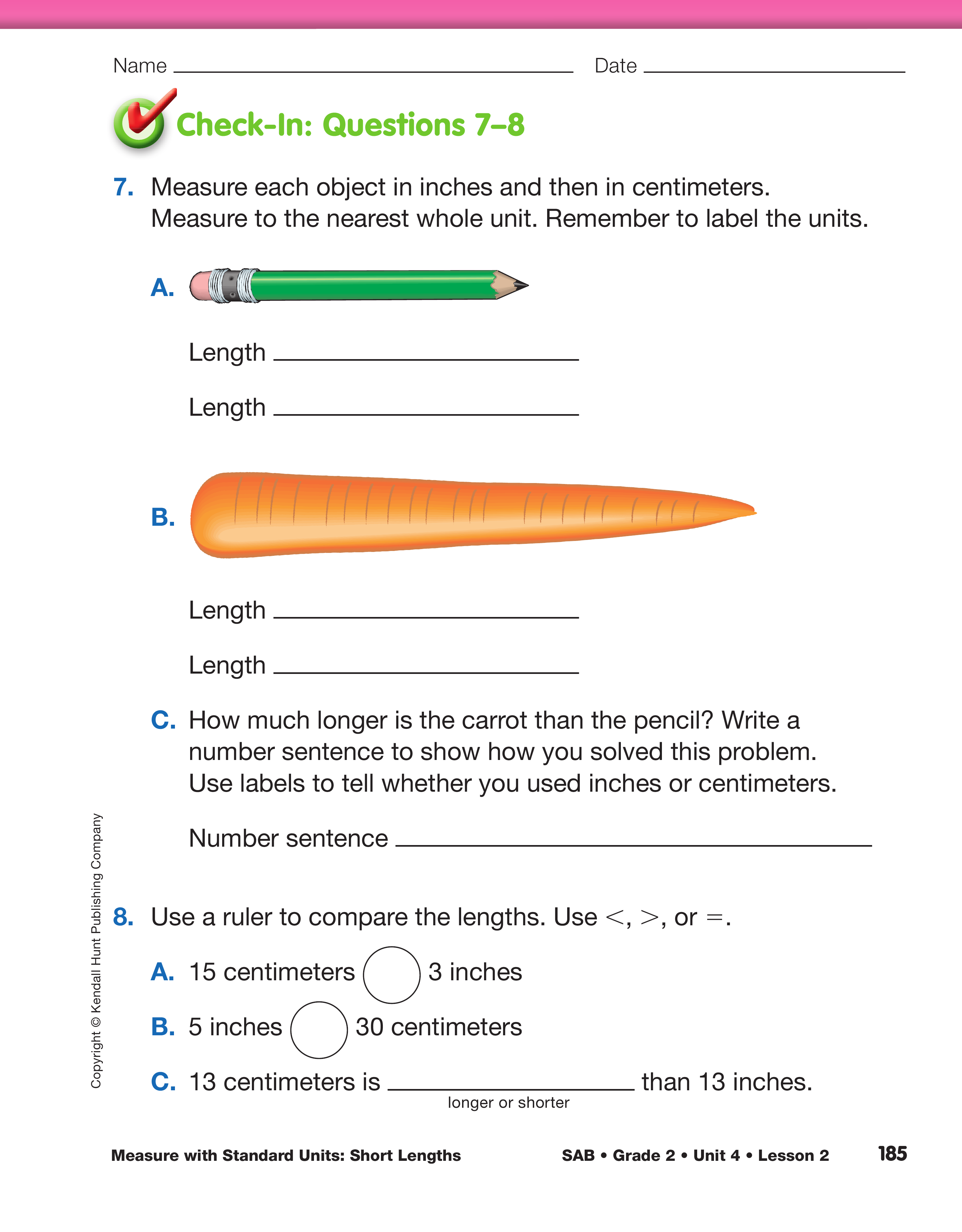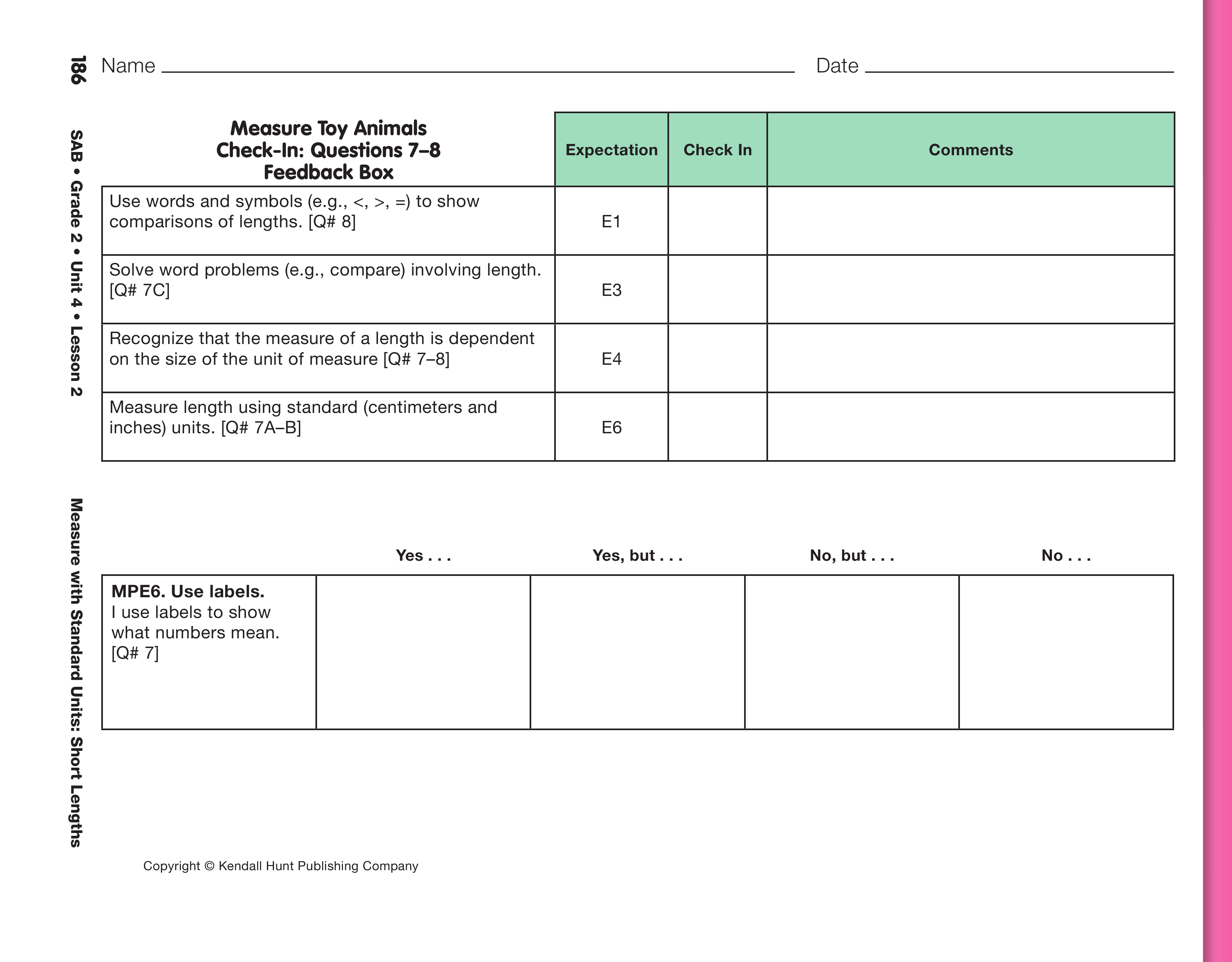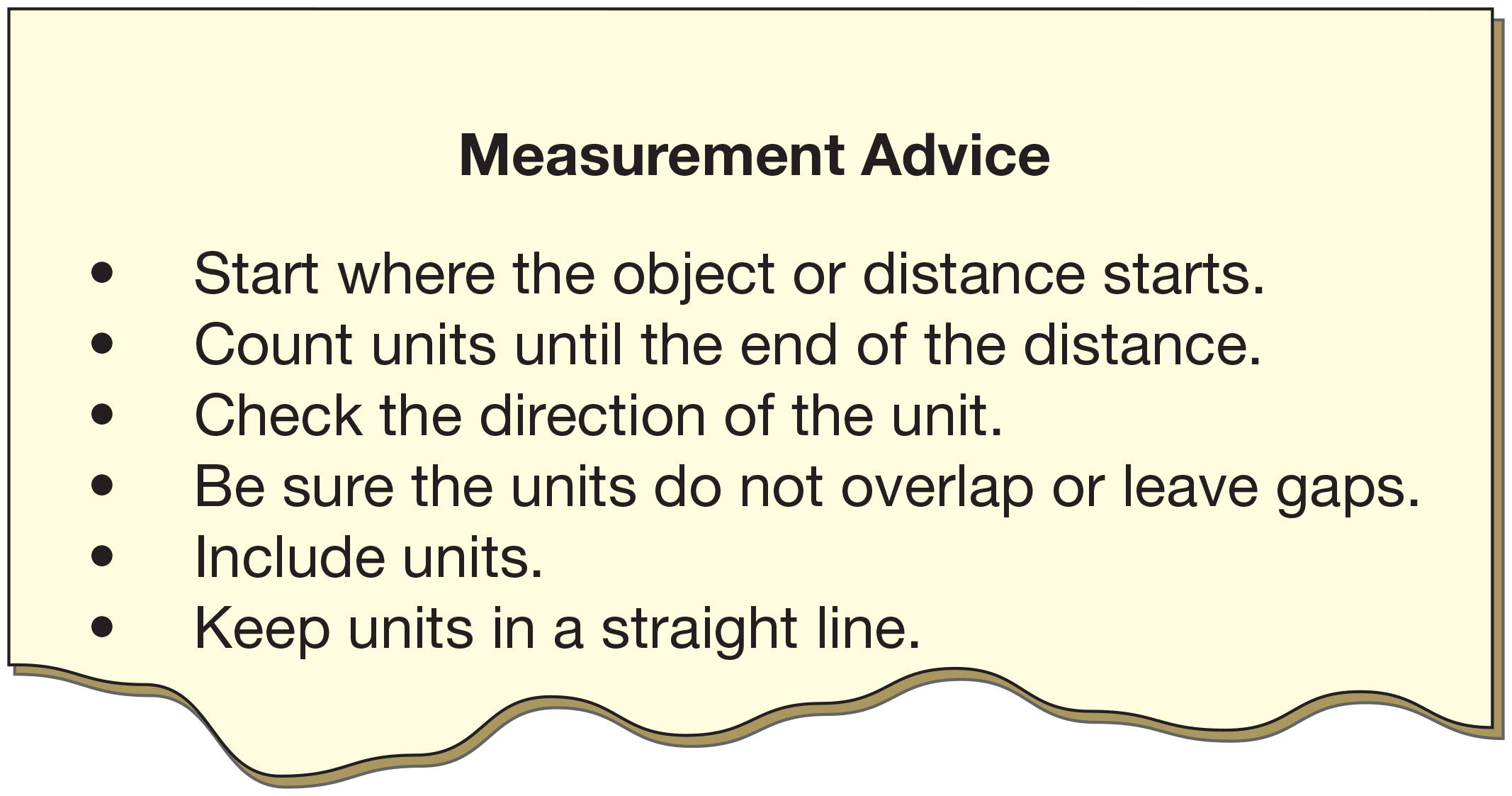Introduce Inches and Centimeters. Display several
examples of nonstandard units as discussed in
Lesson 1 such as Apatosaurus footprints, children's
palms, gorilla palms, and children's footprints.
- What are some of the good things about using
these units to measure? (Possible responses: easy
to do; we can use our hands or feet no matter
where we are; gives us a general idea of the measurement)
- What are some of the problems that we might have
with these units? (Possible responses: They are
all slightly different and each person might get a
different answer depending on the size of their
palm or foot. If a person can't see my hand they
don't know exactly how big it is.)
Display and give each student a centimeter and inch
ruler. Tell students that many years ago, people were
having the same concerns about measuring with
palms and footprints so they invented standard
units of measure. Explain that by using a standard
unit, everyone can get the same measurements.
- What do you notice about each ruler? (Possible
responses: It has lots of lines. It has numbers.
The inch ruler shows 12 inches. The centimeter
ruler shows 30 centimeters. The units on the inch
side are the same size. The centimeters are all the
same size. There are units smaller than an inch
and a centimeter shown on the ruler.)
- Compare the inch to the centimeter. Which unit is
larger? (inch)
- How many inches are on your ruler? (12)
- How many centimeters are on your ruler? (30)
- Why are there fewer inches than centimeters on
the ruler? (Possible response: The centimeter unit
is smaller so more are needed to measure the
same distance.)
- Compare your ruler to your neighbor's ruler. Are
the inches the same size? Are the centimeters the
same size? (Yes, each unit is the same size. The
units are standardized.)

The common system of measurement in the United States,
the U.S. customary system, uses inches, feet, yards, and
miles to measure length. Most parts of the world use the
metric system, as does most of the scientific community.
Measure in Inches and Centimeters. Display the
Measurement Advice chart from Lesson 1.
See
Figure 1. Review the advice on the chart using the
following prompts:
- Where are you going to start measuring? (Possible
response: at zero on the ruler; at a whole unit on
the ruler)
- How are you going to keep the units in a straight
line? (Possible response: The ruler is straight.)
- How will you decide if the nearest whole unit is
[10 centimeters] or [11 centimeters]?
Have students remove the Measure Lines pages from
the Student Activity Book. Ask them to measure the
lines and complete the questions in Questions A–F.
Remind students of the advice on the chart and use it
to assess them while they are measuring.
When most students have completed Questions A–F,
display the Measure Lines pages and discuss
Questions E–F.
- Did you agree with Luis in Question E? Why or
why not? (Possible response: I do not agree with
Luis. His ruler stopped at 12 but it did not start at
zero. I think the line is 10 centimeters.)
- Do you agree with Emily in Question F? Why or
why not? (Possible response: No, I do not. She
did not count the inches. She simply read the
number opposite the 8 centimeters. I think the
line is 3 inches.)
- Imagine your ruler is broken so you cannot start at
zero. Measure Line C in centimeters but start at 2 centimeters. What do you have to do? (Possible
responses: Take away the 2 centimeters from
where the ruler stops and count the actual centimeters.)
Direct students' attention to the line in Question D.
Lay the inch ruler next to the line, align the first
point with 2 inches, and tell students that you measured
the line to be 5 inches. Show students how to
count the units. See Figure 2.
- Do you agree with my measurement? (No, I measured
the line to be 4 inches not 5 inches.)
- If you all agree that Line D is 4 inches, what do you
think I did? (Possible response: You counted the
numbers rather then the units. You need to count
the space between each number on the ruler.)
- Before we do any other measuring, is there any
advice that should be added to the chart? (Possible response: Count the intervals or spaces
between the numbers. Pay attention to where you
start on the ruler. Pay attention to the unit on the
ruler.)
Measure Toy Animal Lengths. Display the two toy
animals you gathered and two 12-inch rulers. See
Materials Preparation. Explain to students that they
will work with a partner to measure each of their
four animals. Tell students to measure the animals as
if they are lying down taking a nap.
Demonstrate
good measurement skills as you ask the following
prompts:
- What unit can you use to measure the toy animals? (Possible responses: centimeters, inches,
fingerprints, palms)
- Which of these are standard units? (centimeter
and inches)
- Let's look at the larger of my toy animals. Is this
animal more or less than 12 inches long? (more
than 12 inches)
- How can you use a 12-inch ruler to measure the
toy? (Possible response: Find a partner and put
the two rulers together. Use one ruler, make a
mark, and then move the ruler over and add the
measurements together.)
- If you use two rulers, is it important to be careful
about the way you place the second ruler next to
the first ruler? (Possible response: Yes, because if
you place the ruler down the wrong way, your answer will be wrong. You have to turn the second
ruler so it starts with zero.)
- Does the Measurement Advice chart say anything
about what to do if it is more than one ruler in
length? What advice should you add to the chart? (Possible response: Add the measurements from
the rulers together if the length is longer than the
tool. Make sure the rulers are facing the correct
way.)
Collect ideas from the students on how to measure
more than one ruler in length. Emphasize the importance
of including the first ruler's length in the total
measurement. See Figure 3.
When measuring objects greater than 12 inches in length,
many students will find it helpful to use two rulers, rather
than just one, to measure.
Ask student pairs to organize their four stuffed animals
in order, from shortest to longest. Then ask students
to name the animals in the table. The shortest
animal should be identified as Toy Animal A and the
largest as Toy Animal D. Have students work in pairs
to complete the table in Question 1 on the Measure
Toy Animals page in the Student Activity Book. Each
student should measure each of the four animals, and
then pairs should discuss and compare measurements.
- Did you and your partner get the same measurements?
Why? (Yes, because we are using standard
units.)
- If your answers are different, what could have happened? (Possible responses: We didn't follow
one of the pieces of advice; one or both of us
made a mistake; we used the wrong side of the
ruler; I thought the length was closer to [10
inches] and he thought it was closer to [9
inches].) [See Content Note.]
It may be helpful for students to use self-adhesive notes to
label their four toy animals A–D. The labels will help students
identify the toy animals and avoid confusion as students
measure them.

Measurement Error and Mistakes. Any measurement in the
real world is an approximation because any measuring
instrument has a limit to its accuracy. For example, a
centimeter ruler can only measure to the nearest tenth of a
centimeter, so it cannot be used to measure an object
accurately to the nearest hundredth of a centimeter. On the
other hand, a mistake usually refers to an error that arises
because of human carelessness, inattention, or
misunderstanding.
When teaching, it is important to be aware of this distinction.
Measurement error will occur, i.e., different students
measuring the same object with the same unit will
sometimes reach slightly differing results, even when using
correct procedures. On the other hand, if two students get
widely differing measurement results, it is most likely the
result of a mistake, i.e., misunderstanding or using incorrect
procedures. In these instances, it is necessary to draw
attention to the possible causes of the mistake so that the
errors in method or understanding may be addressed.
After students have recorded their measurements for
Question 1 ask:
- Why are your numbers bigger when you measure
with centimeters instead of inches? (Centimeters
are smaller than inches so it takes more centimeters
to cover a length than inches.)
- If a measurement falls between two whole units,
how do you decide which to choose as the measurement? (Possible response: If the space
between the length and the unit is small, I choose
that whole unit. I always go to the larger number
if the length is over a number.)
Compare Animal Measurements. Ask students to
work with a partner to complete Questions 2–6.
When most students have completed the questions,
ask:
- Why didn't you all have exactly the same difference
when you compared the heights in Question
5? (Possible responses: We measured different
animals, and because some of us compared using
inches, and some of us compared using centimeters.)
- Why is it crazy for a teacher to be 4 inches tall? (Possible response: She/he could fit in my hand,
and people can't be that short.)
- What are some other objects that you could measure
in inches or centimeters? (Answers will
vary.)
- Can you think of any object that would be hard to
measure in these units? (Possible response:
extremely large or extremely small objects)
Discuss Question 6E–F.
- Is the statement in Question 6E a "could be" or a
"crazy"? Why? (crazy; Possible response:
Centimeters are smaller so there should be more
of them not fewer of them.)
- Let's say Line Z is 15 centimeters. About how
many inches is the length of the line? (about
6 inches)
- How do you know? (Possible response: I put my
centimeter ruler on top of my inch ruler. I found
15 centimeters on the centimeter ruler and
matched it with the inch ruler. It was about
6 inches.)
- Let's say Line Z is 20 inches long. About how many
centimeters is the length of the line? (Possible
response: about 50 centimeters)
- How did you figure that out? (Possible response: I
know 12 inches is about 30 centimeters. I
matched my centimeter and inch ruler together
and 8 inches is about 20 centimeters.) [See
Figure 4.]
Ask students to complete Check-In: Questions 7–8
independently. Students will need centimeter and
inch rulers.
Use Check-In: Questions 7–8 with the Feedback Box on the
Measure Toy Animals pages in the Student Activity Book to
assess students' abilities to measure using inches and
centimeters [E6]; solve word problems (e.g., compare)
involving length [E3]; use words and symbols to show
comparisons of lengths [E1]; recognize that the measure of
a length is dependent on the size of the unit of measure
[E4]; and use labels [MPE6].
















